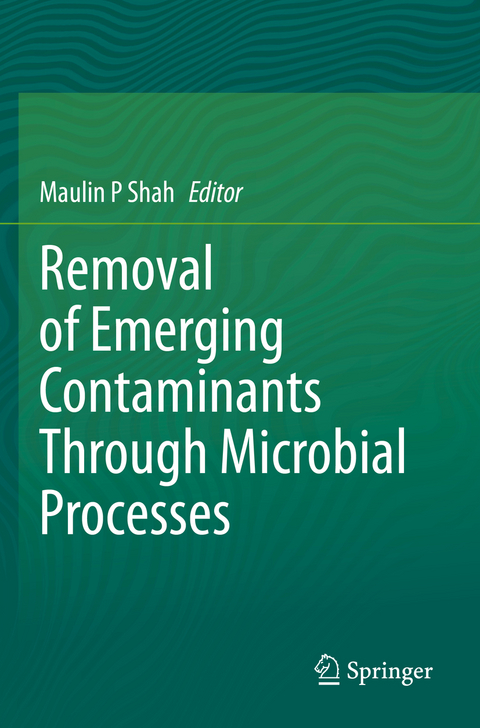
Removal of Emerging Contaminants Through Microbial Processes
Springer Verlag, Singapore
978-981-15-5903-7 (ISBN)
This book provides an up-to-date overview of the current bioremediation strategies, including their limitations, challenges and their potential application to remove environmental pollutants. It also introduces the latest trends and advances in environmental bioremediation, and presents the state-of-the-art in biological and chemical wastewater treatment processes. As such, it will appeal to researchers and policy-makers, as well as undergraduate and graduate environmental sciences students.
Maulin P. Shah is currently the Chief Scientist & Head of the Industrial Waste Water Research Lab, Division of Applied and Environmental Microbiology Lab at Enviro Technology Ltd., India. His work involves areas ranging from applied microbiology, environmental biotechnology, bioremediation, and industrial liquid waste management to solid state fermentation, as well as assessment of the impact of industrial pollution on microbial diversity of wastewater. He has edited 25 books in the area of wastewater microbiology
Chapter 1. ASPECTS OF MICROBIAL BIOFILMS IN WATER TREATMENT.- Chapter 2. New Bioremediation Technologies to Remove Heavy Metals and Radionuclides.- Chapter 3. Removal of heavy metals using bentonite clay and inorganic coagulants.- Chapter 4. Advanced Oxidation Processes for Wastewater Remediation: An Overview.- Chapter 5. Rhizoremediation of heavy metals and xenobiotics contaminated soil: An Eco-friendly approach.- Chapter 6. Bio treatment of High-salinity Wastewater: Current Methods and Future Directions.- Chapter 7. Facing Lethal Impacts of Industrialization via Green and Sustainable Microbial Removal of Hazardous Pollutants.- Chapter 8. Waste water treatment techniques - An Introduction.- Chapter 9. New trends in removing heavy metals from industrial wastewater through microbes.- Chapter 10. Biological Wastewater Treatment Technology; Advancement and Drawback.- Chapter 11. Role of Extremophiles and Extremophilic Proteins in Industrial Waste Treatment.- Chapter 12. Bio sorptionof carcinogenic heavy metals by bacteria: Role and Mechanism.- Chapter 13. The interest in Nanotechnology: A step towards bioremediation.- Chapter 14. Sustainable phyco-remediation of xenobiotics polluted water.- Chapter 15. Fundamentals of Biosensor application in environmental pollutant monitoring.- Chapter 16. Sustainable recovery of resources from industrial waste water: trends in biotechnology and allied industries.- Chapter 17. Accumulation and Detoxification of Metals by Plants and Microbes.- Chapter 18. Enzymatic degradation of industrial wastewater pollutants.- Chapter 19. Exploring the use of bio mixtures for the removal of structurally different pesticides.- Chapter 20. Bioremediation of perfluorochemical: A emerging contaminants present in municipal wastewater.- Chapter 21. Macrophyte importance in contaminant treatment and biomonitoring.- Chapter 22. Decontamination of Aqueous Heavy Metal Ions by Valence Regulation Strategy.- Chapter 23. Mechanistic insight to bioremediation of hazardous metals and pesticides from water bodies by microbes.- Chapter 24. Reuse of Water: An integral approach for the survival.- Chapter 25. Toxicity of hexavalent chromium and its microbial detoxification through bioremediation.
| Erscheinungsdatum | 25.10.2021 |
|---|---|
| Zusatzinfo | 48 Illustrations, color; 13 Illustrations, black and white; IX, 542 p. 61 illus., 48 illus. in color. |
| Verlagsort | Singapore |
| Sprache | englisch |
| Maße | 155 x 235 mm |
| Themenwelt | Naturwissenschaften ► Biologie ► Mikrobiologie / Immunologie |
| Naturwissenschaften ► Biologie ► Ökologie / Naturschutz | |
| Technik ► Umwelttechnik / Biotechnologie | |
| Schlagworte | Advanced oxidation processes • biodegradation • Biofilms • Detoxification • nanotechnology • Phytoremediation • Synthetic Dyes • Wastewater Treatment |
| ISBN-10 | 981-15-5903-1 / 9811559031 |
| ISBN-13 | 978-981-15-5903-7 / 9789811559037 |
| Zustand | Neuware |
| Haben Sie eine Frage zum Produkt? |
aus dem Bereich


